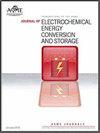Fuzzy logic control-based charge/discharge equalization method for lithium-ion batteries
IF 1.9
4区 工程技术
Q3 ELECTROCHEMISTRY
Journal of Electrochemical Energy Conversion and Storage
Pub Date : 2023-02-23
DOI:10.1115/1.4056989
引用次数: 0
Abstract
In this paper, a grouping equalization circuit based on the Single Ended Primary Inductor Converter (SEPIC) circuit is proposed, which can transfer energy between any single cell or grouped cells. Compared with the traditional equalization circuits that transfer energy between adjacent cells, the SEPIC circuit can directly connect any two batteries that need to be equalized; the number of circuit equalization paths is calculated based on a directed graph, then used as a basis for grouping the batteries to improve the equalization efficiency. In the charging or discharging condition, the amount of charge remaining in the battery to be charged or discharged is used as the control variable for equalization, and intra-group equalization is completed before inter-group equalization starts. To ensure the equalization efficiency of the battery, the equalization current is controlled by fuzzy logic control (FLC). Taking 10 single cells as an example based on the calculation of the number of equalization paths, two 5-cell groups can be confirmed as the optimal solution. Experiments were performed on Matlab/Simulink simulation platform, and the results show that compared with the traditional adjacent inductance equalization circuit, the equalization circuit proposed above reduces the time needed for equalization by 35.8%; Compared with the traditional average difference method, in charging and discharging conditions, the FLC algorithm saves times by 20.5% and 31.3% respectively, and energy loss is reduced by 9.1% and 5.5% respectively, which verifies the feasibility of the proposed equalization scheme.基于模糊逻辑控制的锂离子电池充放电均衡方法
本文提出了一种基于单端初级电感变换器(SEPIC)电路的分组均衡电路,该电路可以在任何单个单元或分组单元之间传输能量。与传统的在相邻电池之间传递能量的均衡电路相比,SEPIC电路可以直接连接任何两个需要均衡的电池;基于有向图计算电路均衡路径的数量,然后将其用作对电池进行分组的基础,以提高均衡效率。在充电或放电条件下,将待充电或放电的电池中剩余的电荷量用作均衡的控制变量,并且在组间均衡开始之前完成组内均衡。为了保证电池的均衡效率,均衡电流采用模糊逻辑控制(FLC)进行控制。以10个单小区为例,通过计算均衡路径的数量,可以确定两个5小区组为最优解。在Matlab/Simulink仿真平台上进行了实验,结果表明,与传统的相邻电感均衡电路相比,上述均衡电路将均衡所需时间减少了35.8%;与传统的平均差分法相比,在充电和放电条件下,FLC算法分别节省了20.5%和31.3%的时间,能量损失分别减少了9.1%和5.5%,验证了所提出的均衡方案的可行性。
本文章由计算机程序翻译,如有差异,请以英文原文为准。
求助全文
约1分钟内获得全文
求助全文
来源期刊

Journal of Electrochemical Energy Conversion and Storage
Engineering-Mechanics of Materials
CiteScore
4.90
自引率
4.00%
发文量
69
期刊介绍:
The Journal of Electrochemical Energy Conversion and Storage focuses on processes, components, devices and systems that store and convert electrical and chemical energy. This journal publishes peer-reviewed archival scholarly articles, research papers, technical briefs, review articles, perspective articles, and special volumes. Specific areas of interest include electrochemical engineering, electrocatalysis, novel materials, analysis and design of components, devices, and systems, balance of plant, novel numerical and analytical simulations, advanced materials characterization, innovative material synthesis and manufacturing methods, thermal management, reliability, durability, and damage tolerance.
 求助内容:
求助内容: 应助结果提醒方式:
应助结果提醒方式:


